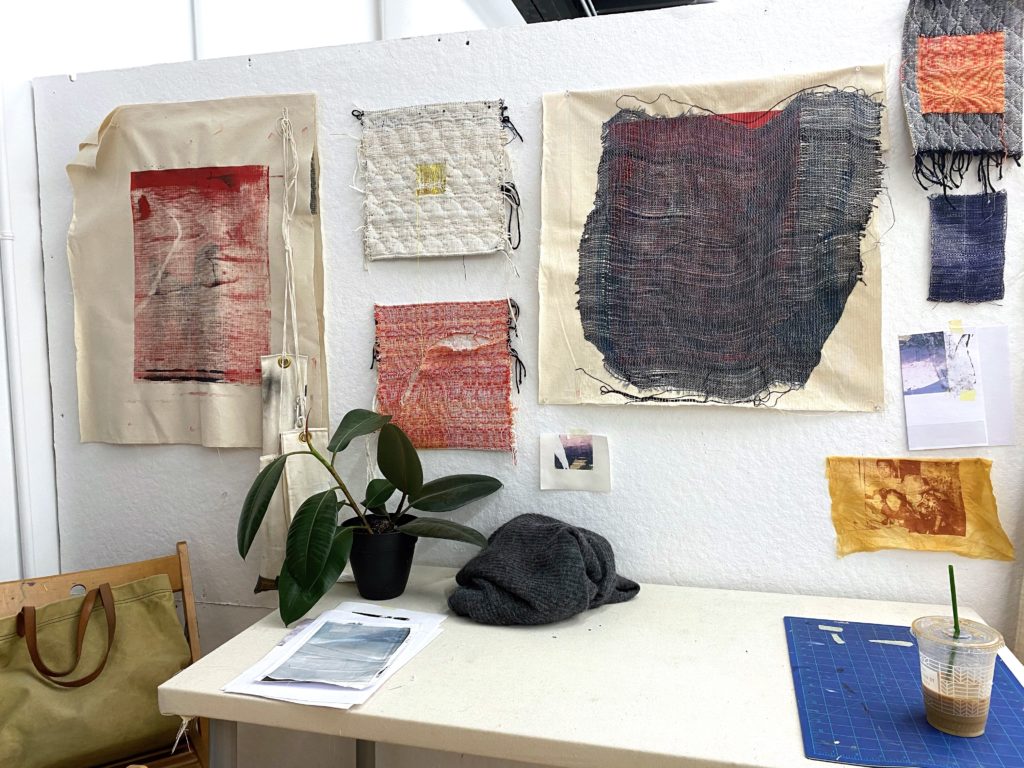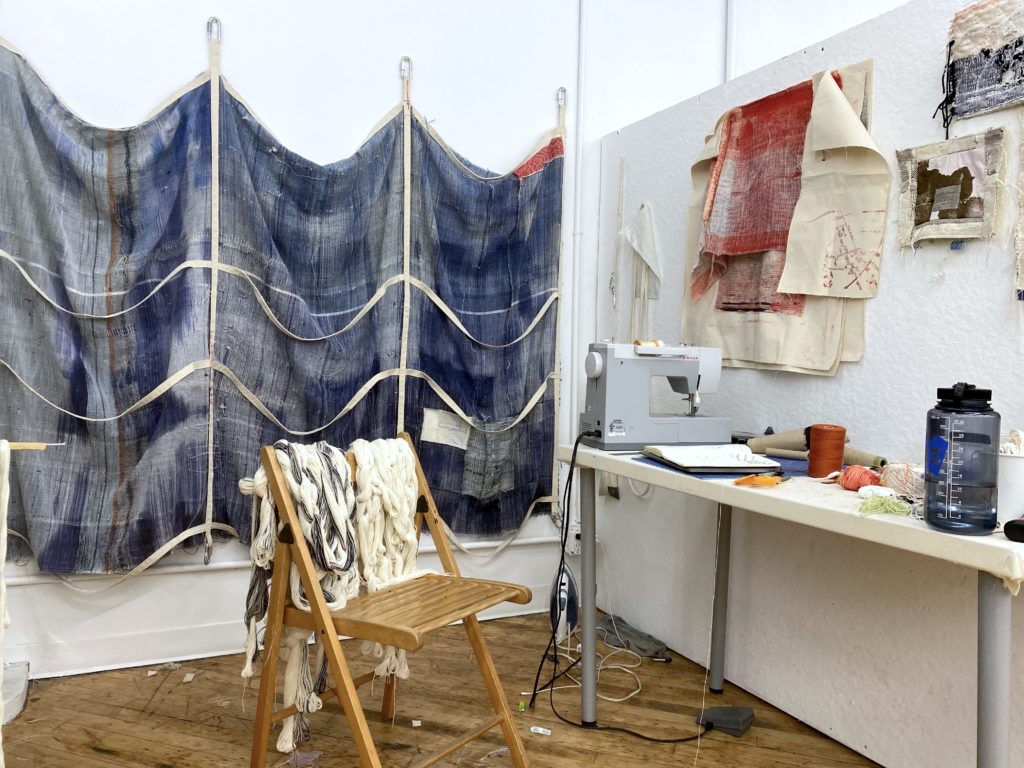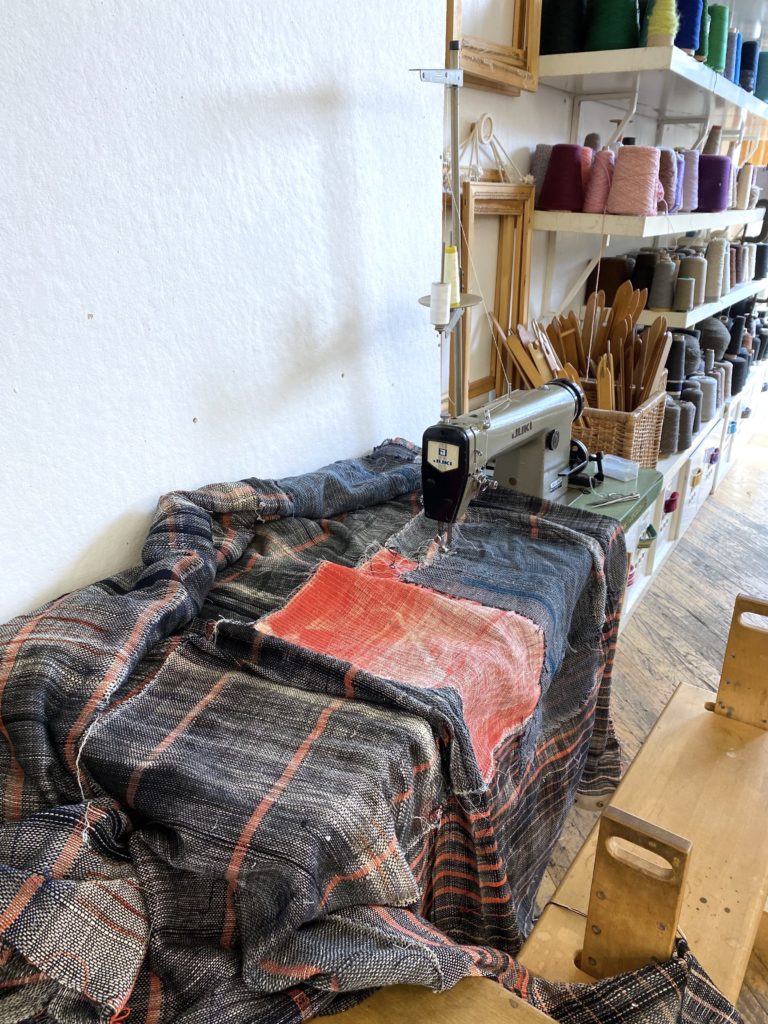AIR Highlight: Clare Hu
This conversation took place on June 28, 2021 at the Textile Arts Center with Clare Hu and Isa Rodrigues
Video Visual Description:
Footage of Clare Hu, wearing a white striped shirt, silver earrings and a grey face mask. She has dark brown hair down to her shoulders and tattoos along her arms. In the foreground on the right hand side, is the blurry silhouette of Isa’s light face and dark curly hair. The conversation is happening in Clare’s studio at the Textile Arts Center, and Clare and Isa are sitting at Clare’s desk, across from each other. In the background, on the walls, is one of Clare’s handwoven tarps, a canvas harness structure and handwoven and stitched panels. Some points of the video span around textiles as they are described in the interview.
Clare Hu (she/her) is an artist and weaver currently based in Brooklyn, NY. In her work, haptic skips of woven textiles gone awry, the distortion of image dictated by the hand, and games of hide and seek inform the use of weaving, mended imagery and installation, to examine false histories and notions of the South. By utilizing slow craft, Clare Hu dissects how Southern myths are acted and re-enacted in the stories and objects surrounding them, and particularly, the kinds of debris left behind.
Clare completed her BFA with a focus in Fiber and Material Studies at the School of the Art Institute of Chicago (SAIC), and has received additional training in textiles from the Gerrit Rietveld Academie in the Netherlands. She is a recent Hambidge Center fellow, and is currently a resident at the Textile Arts Center in Brooklyn.
Isa Rodrigues (she/her) is the co-Executive Director of the Textile Arts Center
Isa: Hi Clare, thank you for having me in your studio. I’m excited to hear more about your work and also about your experience while an artist in residence here at the Textile Arts Center. Do you want to start by introducing yourself and telling us a little bit more about your practice?
Clare: Hi! My name is Clare, I am an artist and weaver originally from Georgia. A lot of my work deals with ideas of Southern nostalgia and ways to interrogate those myths that have been maintained for such a long time. I really do that through woven textiles as well as inserting digital images of my own personal experiences and through my own personal archive as well.
Isa: Clare, what drew you to working with fibers and textile techniques? Was weaving the first textile technique that you experimented with?
Clare: Thank you for the question Isa! (laughs) It’s actually really funny. The first time I ever worked with textiles was when my mom taught me how to knit and mend clothing, when I was I think in second grade. But it really didn’t click for me until I took an intro to fibers class during my second year in my undergrad. That's when I first saw the loom and used the loom and there was something about having the loom as a way to translate my ideas, but also as almost a collaboration tool that I was really drawn to. Throughout my career, being a weaver, it’s been amazing to see how much I could push that tool as a collaborator, and be able to kind of have more improvisation than I first thought when I saw the loom for the first time.
Isa: I love that you called the loom your collaborator and I feel that the way that you push the tool, that is the loom, to also create your vision is sometimes (what we) call a technique flex (laughs). But I feel like you really thrive in it. Do you see yourself continue working mostly with weaving as your main technique?
Clare: I think weaving will always be the basis for whatever I do next. There’s something about the whole process of dressing the loom, figuring out the weaving draft and actually taking the time to weave that, I feel like that it’s so important to my practice, having that time and that labor spent to create multidimensional weaves or to even create an image through warp painting. Yeah, the distortion and everything that comes with that, with working with the loom, is definitely integral to what I do right now.
Isa: Clare, you've been so busy weaving over these last nine months. And you’ve been so prolific. Can you share a little bit more what’s been the focus of your research and your studio practice throughout the residency?
Clare: Yeah, so the residency really was able to give me time to dig into the research that I was really interested in starting off. A lot of my research right now, especially for the tarps, is based on this one area around metro-Atlanta, especially thinking about the Chinese-American communities that heavily migrated there within the 70s and 80s, where the cultural points were how did it grow and shift over time. I think I was really drawn to this area and this history in particular because that’s where my own parents immigrated. When thinking of this, and thinking of Georgia, it’s also hard to ignore the larger Southern implications that are also there as well. Very close to Buford Highway, about 20 minutes down, is Stone Mountain, which is right now a very big tourist spot, but also where a large confederate memorial is. And for me, thinking about how we maintain these Southern nostalgic myths, like the “Lost Cause” and everything that pertains to that, the large commodification, how our textiles can even play a big part into it, was kind of the impetus for the work that I’m doing right now.

Isa: And you’ve been including some of your own images and some of also archive images into these tarps too. Some are woven, but others are other techniques . Can you speak a little bit more about the process of creating these tarps?
Clare: Yeah, so especially thinking about the images, what really drew me to both a public archive and a personal archive, is how this mountain in particular was commodified in such a way and both postcards but how it’s marketed as well, it’s changed so much over time. And shifting to my own personal archive of these restaurants that I used to go with parents, these supermarkets, and all the signage that happens down this highway. Putting the two together and questioning, you know, who’s history is who’s and where does a boundary lay, if there is one, was really important to me. So, during the nine months, I’ve been experimenting this with screen printing as well as warp painting, and even piecing my own digital collages into the weaving as well. I’ve started working on making harnesses for these tarps, so that has also become a way to kind of experiment with showing these images.
Isa: (Looking at the tarp behind Clare) I have seen your work before but the tarps and the harnesses play such an important role on the final pieces. Right now, behind you, we’re seeing one side of the tarp, can you show us the harness?
(Clare unhooks the tarp from the hanging system on the wall, to reveal the harness system on the other side)
Isa: I feel like we talked about this at critique, but you really developed these pieces and you plan to show these pieces in the two sides. Like so, we see the front and we see the harnesses, and I remember us discussing, is the harness supporting the piece or is the tarp supporting the harness. Do you want to talk more about the role of the harnesses within the tarp structure?
Clare: Definitely. So the harness first became a way for me to.. I’ve been weaving these tarps for some many years and I’ve always been thinking of them as a flat textile. But the more I think of the tarp as a symbol for transition, you always see both sides in one place, the more I wanted to think about sculpture and installation of these pieces. And the harness for me became a way to kind of care for these textiles. When I weave them is not the most gentle process, so giving it a place to land afterwards, memorializing them and also them becoming monuments in a gallery space was something that was really important to me. The tarps that, you know, you usually see on a construction site, or I see when I drive down Buford Highway are always the afterthoughts of progress happening. And then taking the time to really move your body around these pieces and really sit with what they are was kind of the reason why I wanted to create these harnesses very specific to the tarps.

Isa: Clare, you mentioned working on several different techniques while in residency and really taking great advantage of the studio facilities and I’d love to hear more about your experience while in residency at TAC and if you want to share any highlights for you of the last nine months.
Clare: Definitely, for me, personally, having access to all the amazing equipment has been great. I was able to experiment with the dobby loom, experiment with screen printing, things I wouldn’t have been able to before. But the thing that I’ll probably leave away with is just the community that we had at TAC. I think for me it really clicked when I had a conversation with Jeanne, before we were doing our Instagram live, where I really got to hear more about her work and ask her questions. And I think, for me, that was able to kind of carry on with everyone else. And it’s definitely, you know… I love everyone here (laughs), and it’ll be really good to take those relationships with me into the future.
Isa: One of the most exciting moments of the residency is the final exhibition, which is coming up in September. And in the last weeks we’ve been discussing all the details about it, you’ve been sharing your plans with each other, discussing layouts.. Can you reveal a little bit more about what we will be able to see at the final show?
Clare: Yeah, so for the final show I’m planning to weave two more tarps very similar to the one behind me, using the same patch processes, as well as thinking about how to collage and piece them back together. One will be an orange and black tarp, and the other will have less imagery but will still be, I think, a significant experiment, following how I’ve been doing the rest of them. It’ll be really exciting.

Isa: As the residency starts to wind down, have you started thinking about what’s next? Do you have any upcoming projects or plans that you’d like to share?
Clare: Yeah, I’ll definitely be taking the time after residency to kind of meditate over everything that I’ve done at the residency. I think that some many new ideas and things that I want to experiment with and make have come from all the current experimentations that I’ve done. So I’m really excited, me and Elaine, another studio mate, are actually sharing a studio, so it’ll be great to continue these conversations that we had here. It’ll be really exciting.
Isa: I love that you’ll be sharing a studio together! Do you think that you’ll continue developing the “tarp” body of work or are you also planning to take a break from this body of work and maybe do some research into a different topic?
Clare: Yeah, I think my mind has already been going on and on about other different weave structures I can use, how the tarps can become miniatures since they become so large already, and then thinking about more ways I can incorporate different drafts and different techniques. I don’t know if I’ll ever be over (laughs). Weaving the tarps will definitely, I think, be a lifelong project, I think it’ll always show up in my work somehow. It’ll be exciting to see what that is.
The TAC AIR 12 Final exhibition, Considering Mass and Density, will be on view at the Textile Arts Center from September 13-26, 2021.